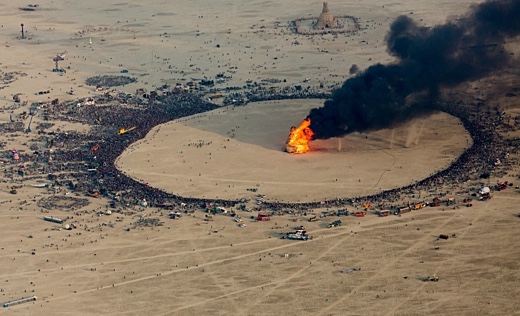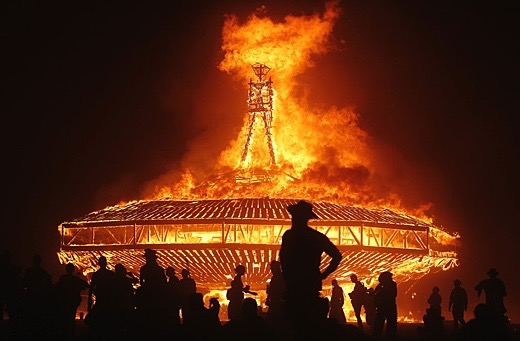SUBHEAD: The coming of the age of scarcity that’s now upon us, though, draws a hard line under techno-fantasies.
By John Michael Greer on 15 August 2013 for the Archdruid Report -
(
http://thearchdruidreport.blogspot.com/2013/08/the-ritual-theater-of-progress.html)
 Image above: "Bad Buddha", oil on canvas, 24x30", 2013 .by Mark Bryan Original and prints available. From (http://markbryan.imagekind.com/store/imagedetail.aspx/2f920e30-56cd-4698-9bc3-4bceaf1529c9/Bad_Buddha).
Image above: "Bad Buddha", oil on canvas, 24x30", 2013 .by Mark Bryan Original and prints available. From (http://markbryan.imagekind.com/store/imagedetail.aspx/2f920e30-56cd-4698-9bc3-4bceaf1529c9/Bad_Buddha).
This habit of drafting my ideas on the future of industrial society right out here in public has its disadvantages, to be sure, but there are benefits as well. One of the more unexpected of these is the way that the illogic that swims through the hidden places of the collective consciousness of our time so often rises to the bait I offer, and thus can be hooked and hauled in for closer examination.
Over the last few weeks, a fine example of the species has landed in my creel. Back in July, in
an earlier post in this sequence about the ways that the mythology of progress holds both science and religion hostage, I noted that fusion researchers have spent the last fifty years trying not to learn the obvious lesson taught by their repeated failures.
Whether or not it’s possible to make a functioning fusion reactor, I pointed out, is immaterial at this point; the last half century of experiments have shown beyond a shadow of a doubt that even if the thing can be done, the cost of building fusion reactors will be so high that fusion will never be economically viable as a source of electricity for the grid.
Before we go on, I’d like to ask everyone to reread that last sentence, and notice that this argument doesn’t claim that fusion reactors are impossible—that, in point of fact, it doesn’t deal at all with the issue of whether fusion power is technically feasible. This may seem like an obvious point, but I can assure you, dear reader, that it’s far from obvious to a good many of my readers. Over the weeks that followed, in fact, I fielded a flurry of comments chiding me for my supposed insistence that harnessing fusion power is impossible.
Quite a range of different arguments were deployed in an effort to dispute this point, ranging from the plausible to the frankly silly; the one thing that none of these commenters seem to have noticed is that the claim they were imputing to me is one I hadn’t made.
Longtime readers of this blog will know that this is far from the first time this odd sort of paralogic has featured on the Archdruid Report comments page. A few years ago, for example, I was rash enough to point out in a post on the future of technology that the internet’s long-term viability in a deindustrializing world will not depend on whether maintaining an internet in such conditions is technically feasible, or whether it can do things that today’s geekoisie consider cool.
Rather, I suggested, the survival of the internet will depend on whether it can pay for itself in a world where energy and resources will be much more scarce and expensive than they are today, and whether it can compete with other ways of providing the same services that are less dependent on extravagant inputs of depleting resources and complex technological infrastructures.
I found the response to this suggestion utterly fascinating. The commenters who showed up to insist that the internet had to survive the end of the present age of fossil-fueled abundance didn’t dispute my argument; they didn’t mention it at all. Instead, they pretended that the point I’d raised had never been brought into the discussion, and insisted over and over again that keeping the internet viable in a deindustrializing world was technically feasible, that the internet can do all kinds of things that today’s geekoisie consider cool, and that the survival of the internet was therefore certain.
Even when I pointed out to them in the comments that they were evading the issue I was raising, they kept on trying to talk about technical feasibility and the cool stuff the internet can do, and to pretend that economic limits had never been mentioned. This went on for three weeks of posts and commentary, until I finally shook my head and went on to the next topic.
This sort of paralogic isn’t unique; it isn’t even unusual. Long before I started this blog, I noticed that any question at all about the economic viability of technological progress lies squarely in industrial civilization’s blind spot. Pick any technology that fits the canned image of the future projected by pop culture, and try to talk about whether we can actually afford to pursue it—in most cases, this is a far more crucial question than most people realize, so it’s rarely difficult to find points to raise—and you can count on the identical response.
For a long time, I wondered why this particular issue should be subject to such remarkable distortions of thought and conversation; over the course of the last few weeks, as I reflected on the latest round of paralogic in the context of the current series of posts, I think I’ve come to understand the reasons behind it.
To make sense of those reasons, it’s going to be necessary to take what will look like a drastic detour, and talk about the role of ritual theater in the world’s religions. I don’t happen to know of a faith on the planet that doesn’t have at least some examples of this very common practice.
Modern societies are no exception to the rule; those of my readers who grew up Christian, for example, and recall Nativity plays and Easter pageants from their childhoods, already know as much about ritual theater as they’ll need to know to grasp what follows.
Ritual theater doesn’t follow the same rules as the secular drama that’s found in today’s playhouses, cineplexes, and DVD racks. There are no surprises in ritual theater, no unexpected plot twists, no unfamiliar characters, and for good reason. The point of ritual theater in a religious context is to enact whatever’s seen as eternally true in the religious tradition that sponsors it.
Depending on your religion, what’s eternally true may be revealed in some specific historical event—say, the Buddha beneath the Bo tree or Christ on the cross—or in some recurring natural event—say, the cycle of the seasons—or it may be permanently outside of time, symbolized by myths which “never happened but always are,” as the Greek philosopher Symmachus put it. One way or another, some blend of folk imagination and the creative genius of individuals makes these things visible in ritual theater, which represents (literally, re-presents) the eternal in a form that everyone can experience.
There’s a lot of variation between one religion’s ritual theater and another’s, but within any given tradition, the plot outline and the emotional reactions sought by the performance tend to be as stereotyped as a politician’s campaign speech.
Pick any of the early Greek tragedies—these were originally enacted at religious festivals in Athens, and so are classic examples of ritual theater in more senses than one—and you can pretty much count on watching a proud and gifted individual have his life destroyed by the incomprehensible decrees of the gods.
That was the structure of ancient Greek ritual drama, and the response, as Aristotle describes it, was an emotional catharsis of pity and terror in which an ancient Greek audience reconciled themselves to their place in the cosmos as mortals subject to the awesome and inscrutable immortals.
It would have been unthinkable to Aeschylus or Sophocles to have a god pop up in the middle of the stage at the climax of the play and fix everything. What was utterly inappropriate in the early Greek ritual theater, though, became common in the later secular drama of the classical world, where deus ex machina—literally, the god out of the stage machinery—was so common as to become a catchphrase.
Christian ritual theater, which emerged out of late classical drama, proceeded to take that experience as its central theme. What JRR Tolkien in a brilliant essay called “eucatastrophe”—the sudden, shattering reversal that transforms tragedy into triumph—thus became the core experience of Christian ritual theater, passed on via the mystery plays of the Middle Ages straight through to the passion plays and parochial school pageants of the present time.
Leap to the other end of the Old World and you’ll find a completely different mode of ritual theater in the Noh drama of Japan. The most common story line among Noh plays has a wandering priest making his way through unfamiliar country. He happens on someone he takes for an ordinary village girl, or some other perfectly natural person. As she sings and dances her story, though, it gradually becomes apparent that she is a supernatural being of some kind—a ghost, a demon, a spirit or a deity—whose destiny the priest may change through his own power and piety, or may simply witness.
The whole drama serves to communicate the distinctive religious vision of Japanese folk culture, in which the supernatural shimmers through the apparent solidity of the ordinary world like colors in shot silk.
Civil religions have their own traditions of ritual theater. Here in America, back in the day, school pageants on George Washington’s birthday and civic celebrations on the Fourth of July routinely copied all the standard forms of religious ritual theater, complete with the utterly stereotyped plots and the predictable emotional reactions common throughout the genre. I don’t happen to know whether the Young Communists’ Leagues of the former Eastern Bloc countries did the same sort of pageants for May Day, though I wouldn’t be the least surprised to learn that they did.
Tolerably often, though, the ritual theater of civil religions takes a less self-consciously dramatic form, and gets acted out in some facsimile of real life: think of the show trials of Stalin’s Russia, in which thousands of people were coerced into acting out the role of wicked dupes of the capitalists, and were then rewarded for their performances with a bullet to the brain.
The civil religion of progress by and large has kept its own ritual theater out of the realm of formal performance, but makes up for this by trying to enact its stereotyped dramas in every possible informal venue. Those of my readers who haven’t been hiding under a rock since the days of Galileo already know the plot of those dramas right down to the finest of details. They begin with a lone genius who shakes himself free of the prejudices and superstitions of the ages, and thus manages to see some part of the world clearly for the first time.
The dramatic action emerges out of the conflict between the lone genius and his (or, very rarely, her) less gifted contemporaries, who defend those prejudices and superstitions against the efforts of the genius to upset the applecart of conventional thought.
The plot thus defined includes a few variations, mostly involving the end of the story. The genius may be condemned and killed by the outraged authorities of his time, only to be vindicated and glorified by future generations. He may struggle on gamely to the end of his life, ignored or denounced by all right-thinking people, and then be vindicated and glorified by future generations.
Alternatively, he may triumph over the opposition by proving his case conclusively, and having vindicated himself, is then glorified by future generations. In each case, the emotional reaction expected from the audience is the same: identifying themselves with the future generations just mentioned, they are called on to glorify the great heroes of progress, to rejoice in the salvation from the prejudiced and superstitious past that these heroes have conferred on them, and to wait expectantly for the even more wonderful things that future heroes of progress will inevitably bring the world in times to come.
A detail worth special attention here, though, is the debate between the lone genius and his prejudiced and superstitious adversaries that always, explicitly or implicitly, fills the middle act of the drama. There’s no more thoroughly stereotyped scene in the whole field of ritual theater.
The adversaries of progress have a set of standard lines assigned to them by the standard plot. They are supposed to point out that whatever idea or technology the lone genius is championing violates the immemorial order of the cosmos or the authoritative teachings of the past, to insist that whatever it is can’t be true or won’t work, and to warn that if the idea is accepted or the technology put into general use, some kind of horrible fate will follow in short order.
The lone genius, in turn, is assigned a set of standard counterarguments to overcome these ceremonial talking points. He is supposed to say that the onward march of human knowledge has rendered the immemorial order of the cosmos and the authoritative teachings of the past obsolete, that whatever innovation he’s championed is true or will work, and that it will bring immense benefits to the human race in the years to come. Both sides recite their parts in the second act, fulfilling the requirements of the script, and in the third act the lone genius triumphs, posthumously or otherwise.
I’ve pointed out already
ina previous post in this sequence that this stereotyped script has been pushed onto the history of thought incessantly by the popular culture of our age, even when it’s been necessary to twist history hopelessly out of shape to make it fit the storyline, as it’s usually been. It’s important to recognize how great a distortion the ritual theater of progress has imposed on our sense of our own past, but it’s at least as important to notice the ways in which the same ritual theater structures debates over technology here and now.
The discussions of fusion power and the future of the internet I mentioned earlier are cases in point. The issue I was raising was not one of the ceremonial arguments that the opponents of technology are supposed to utter in the second act of the drama. I broke the rules of the ritual theater of progress, and after a brief interval of consternation, the other actors in the drama did the logical thing and brought out their own ceremonial counterarguments, as though I hadn’t been so silly as to forget my proper lines.
When I proceeded to break the rules again by drawing attention to the issue I’d actually raised, rather than the one that I was assigned by the script, they got thoroughly flummoxed; some retired in dismay, while others kept on trying to follow their scripts even though I’d gone out and ignored mine.
I can sympathize with their feelings. Still, it’s probably worth noting here that not all discussions of science, technology, and other holy symbols of the civil religion of progress are meant to provide venues for the ritual theater of that faith.
If fusion power and the internet were purely spiritual realities—say, two of the blessings that the faithful could expect to receive after death in some kind of techno-heaven buzzing with starships, jetpacks, and domed cities—that would be a different matter, but fusion reactors, internet data centers, and the like are also expected to solve practical difficulties here on earth.
That means that a discussion of their prospects arguably ought to extend beyond the limits of ritual theater, and include points that aren’t part of the ceremonial dialogue.
That is to say, whether a technology makes economic sense in a world of rapidly depleting resources and spiraling economic dysfunction is a valid concern, whether or not that concern conforms to the stereotyped arguments of our time. If some future iteration of ITER finally gets a sustained fusion reaction going, that’s an intriguing bit of experimental physics, but unless that event leads to the discovery of some way to maintain such a reaction that costs a couple of orders of magnitude less than $14 billion per reactor, that’s all it is—and since every cheaper option has been tried in half a century of very well funded experimentation, it’s a safe bet that in fact, that’s all it is.
This was already recognized in the early 1980s. I recall independent studies in the appropriate tech scene in those days, which showed that if the relatively simple tokamak reactors being tested in those days could be made to work, the result would be a power plant that would produce about as much electricity as a standard fission reactor, at roughly ten times the cost.
Given that fission power is the most expensive source of electricity in common use today, and has never been economically viable anywhere on earth without massive government subsidies, this is not exactly encouraging.
It’s thus not hard to imagine a future in which, let’s say, excited physicists announce to the world that sustained nuclear fusion has finally been accomplished, using some elaborate new reactor design ten times more expensive, adjusting for inflation, than those relatively simple tokamak reactors that failed to do the job in the early 1980s.
Running the numbers, governments and utility companies calculate that, including all economies of scale, each new fusion reactor would cost a hundred times as much as a comparable fission reactor, with consumer bills to match. Has the energy crisis been solved? Not in any sense meaningful in the real world.
In the real world, a technology has to be economically feasible to build and use, or it doesn’t matter. It really is as simple as that. The galloping economic expansion of the age of cheap abundant energy now visible in history’s rearview mirror made it possible to ignore that unwelcome reality for a time, or at least to pretend that it didn’t matter—you’ll notice that the grandiose plans to cover Manhattan with a dome and give it a year-round climate of 72°F and no rain, along with a great many other economically preposterous projects of the recent past, never even got to the detailed-blueprint stage.
The coming of the age of scarcity that’s now upon us, though, draws a hard line under such fantasies. From now on into the foreseeable future, the first question that has to be asked about any technological project is “Can we afford to use it?” The second, which needs to be asked immediately after the first, is “Are there ways to do the same thing less expensively?”
These questions may not be part of the ritual theater of the civil religion of progress, but I’d like to suggest that consoling true believers in that faith with assurances of the invincibility of their surrogate deity may be less important just now than dealing with the imminent impact of the end of abundance and the twilight of the industrial age.
.








 . The more you shop, the more you want, even though we want for very little.
. The more you shop, the more you want, even though we want for very little.  to find each other, communicate, commiserate, educate and validate. In the spirit of the season, recognize their contributions to your worldview: it’s undeniable, and it’s based in a foundation of genuine concern for the planet, the civilization, and for you. Real people write those posts and blogs. Send them emails or messages, with greetings and gratitude if you are so moved.
to find each other, communicate, commiserate, educate and validate. In the spirit of the season, recognize their contributions to your worldview: it’s undeniable, and it’s based in a foundation of genuine concern for the planet, the civilization, and for you. Real people write those posts and blogs. Send them emails or messages, with greetings and gratitude if you are so moved. 


